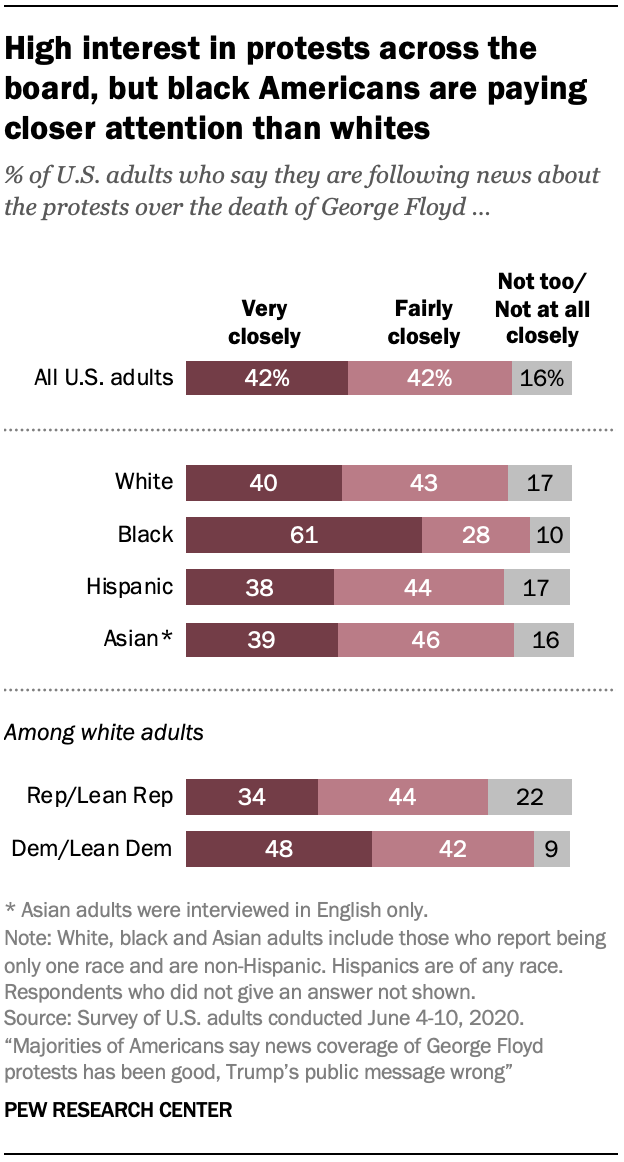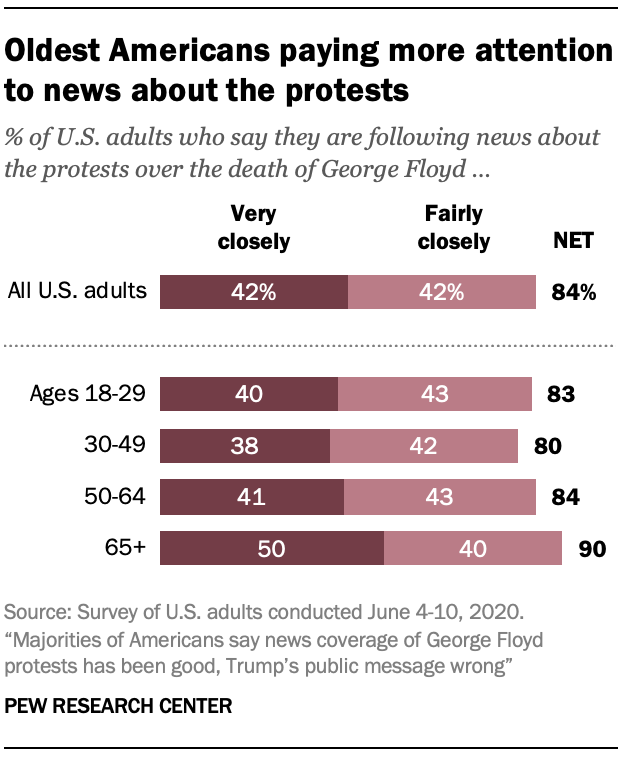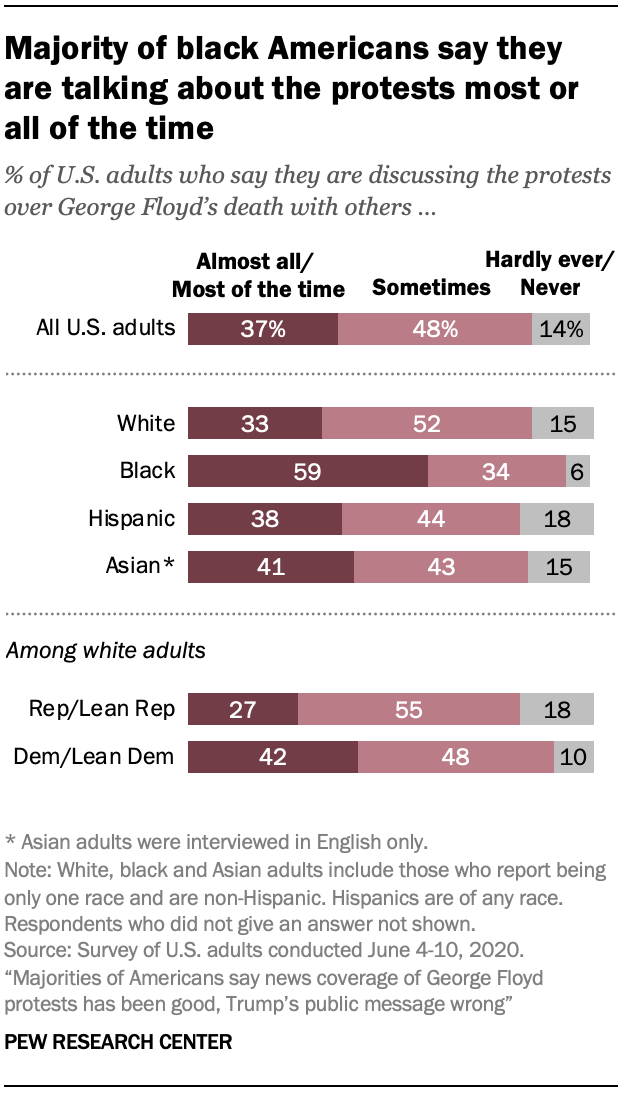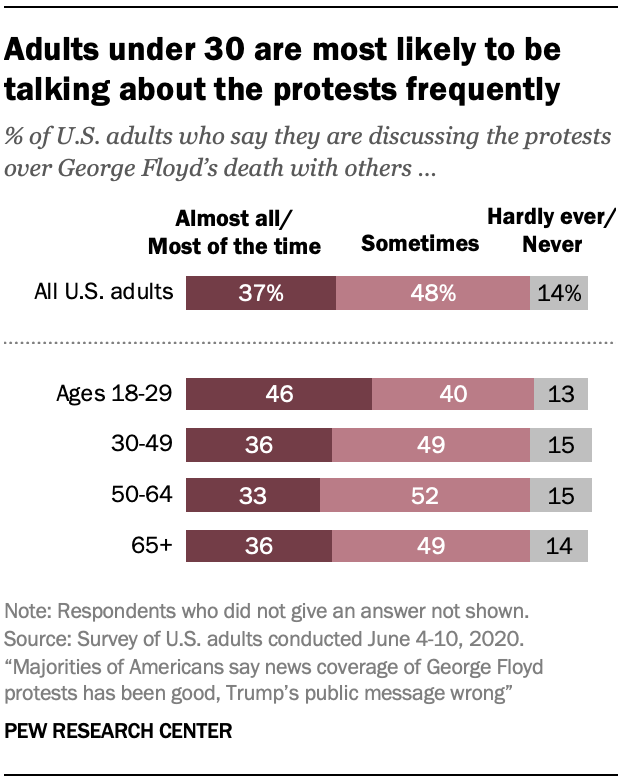 Most Americans are following news about the nationwide demonstrations to protest the death of George Floyd, a black man killed while in Minneapolis police custody. More than eight-in-ten U.S. adults say they are following the story “very” (42%) or “fairly” closely (42%), while far fewer say they are following it “not too” (14%) or “not at all” closely (3%). The levels of interest in the protests nearly match the shares of Americans who were following news about the coronavirus outbreak in late April, before Floyd’s death.2
Most Americans are following news about the nationwide demonstrations to protest the death of George Floyd, a black man killed while in Minneapolis police custody. More than eight-in-ten U.S. adults say they are following the story “very” (42%) or “fairly” closely (42%), while far fewer say they are following it “not too” (14%) or “not at all” closely (3%). The levels of interest in the protests nearly match the shares of Americans who were following news about the coronavirus outbreak in late April, before Floyd’s death.2
Interest in news about the protests over George Floyd’s death is high across all racial and ethnic groups studied. Around eight-in-ten white (83%), Hispanic (82%) and Asian adults (84%) are following the protests very or fairly closely.3 And about nine-in-ten black adults (89%) are following at least fairly closely, including a majority of blacks (61%) who say they are following this news very closely.
While partisan differences often emerge among white adults, interest is high among both white Americans who identify with or lean toward the Democratic Party and white Republicans and Republican leaners. About eight-in-ten or more white Democrats and white Republicans are following the protests at least fairly closely, though white Democrats are more likely than white Republicans to be following the story very closely (48% vs. 34%).
 As seen in news habits more broadly, the oldest group of Americans are more engaged with the story than younger Americans. Fully nine-in-ten U.S. adults ages 65 and older (90%) say they are following it at least fairly closely – including half who say they are following it very closely. Adults ages 18 to 29, 30 to 49, and 50 to 64 are somewhat less engaged; still, large majorities of all these groups say they are following the protests.
As seen in news habits more broadly, the oldest group of Americans are more engaged with the story than younger Americans. Fully nine-in-ten U.S. adults ages 65 and older (90%) say they are following it at least fairly closely – including half who say they are following it very closely. Adults ages 18 to 29, 30 to 49, and 50 to 64 are somewhat less engaged; still, large majorities of all these groups say they are following the protests.
Black Americans, young adults most likely to talk to others about the protests
 In addition to following the news closely themselves, most Americans are spending time talking with others about the protests over George Floyd’s death. Roughly four-in-ten U.S. adults (37%) say they are talking about it “almost all” or “most” of the time. Another 48% say they “sometimes” discuss it with others, while just 14% “hardly ever” or “never” discuss it.
In addition to following the news closely themselves, most Americans are spending time talking with others about the protests over George Floyd’s death. Roughly four-in-ten U.S. adults (37%) say they are talking about it “almost all” or “most” of the time. Another 48% say they “sometimes” discuss it with others, while just 14% “hardly ever” or “never” discuss it.
The protests are a more common topic of conversation for black Americans than other racial and ethnic groups. A majority of black adults (59%) say they are discussing the protests with others at least most of the time, including 30% who say they are talking about them almost all of the time. Fewer white adults, 33% in all, say they are talking with others about the story almost all (8%) or most (25%) of the time. Hispanic and Asian Americans fall in between blacks and whites – about four-in-ten in each ethnic group are talking frequently about the protests.
Just as they are following the story of the protests more closely, white Democrats are more likely than white Republicans to discuss the protests with others. About four-in-ten white Democrats (42%) say they are discussing the story all or most of the time, compared with 27% of white Republicans.
 While adults ages 65 and older are the most likely to follow news about the protests over Floyd’s death, it is the youngest adults, ages 18 to 29, who report talking about the protests with others most often.
While adults ages 65 and older are the most likely to follow news about the protests over Floyd’s death, it is the youngest adults, ages 18 to 29, who report talking about the protests with others most often.
Slightly less than half of adults ages 18 to 29 (46%) say the protests come up almost all the time or most of the time in their conversations. The share saying the same is about 10 percentage points lower in each of the other age groups.


